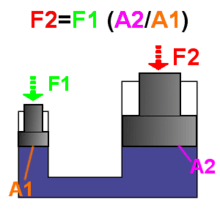Hydraulic press

A hydraulic press is a device (see machine press) using a hydraulic cylinder to generate a compressive force. It uses the hydraulic equivalent of a mechanical lever, and was also known as a Bramah press after the inventor, Joseph Bramah, of England.[1] He invented and was issued a patent on this press in 1795. As Bramah (who is also known for his development of the flush toilet) installed toilets, he studied the existing literature on the motion of fluids and put this knowledge into the development of the press.[2]
Principle
The hydraulic press depends on Pascal's principle: the pressure throughout a closed system is constant. One part of the system is a piston acting as a pump, with a modest mechanical force acting on a small cross-sectional area; the other part is a piston with a larger area which generates a correspondingly large mechanical force. Only small-diameter tubing (which more easily resists pressure) is needed if the pump is separated from the press cylinder.
Pascal's law: Pressure on a confined fluid is transmitted undiminished and acts with equal force on equal areas and at 90 degrees to the container wall.
A fluid, such as oil, is displaced when either piston is pushed inward. Since the fluid is incompressible, the volume that the small piston displaces is equal to the volume displaced by the large piston. This causes a difference in the length of displacement, which is proportional to the ratio of areas of the heads of the pistons, given that volume = area × length. Therefore, the small piston must be moved a large distance to get the large piston to move significantly. The distance the large piston will move is the distance that the small piston is moved divided by the ratio of the areas of the heads of the pistons. This is how energy, in the form of work in this case, is conserved and the Law of Conservation of Energy is satisfied. Work is force applied over a distance, and since the force is increased on the larger piston, the distance the force is applied over must be decreased.
Bramah's basic idea is also exploited in hydroforming.

Application
Hydraulic presses are commonly used for forging, clinching, moulding, blanking, punching, deep drawing, and metal forming operations. Hydraulic Presses have made great strides in the past few decades, faster speeds, less piping, few places for leaks, higher accuracy. New technology with the [3] I-PRESS AB PLUS press and automation control provides end users to program, pressures, speeds and distances of slide or cushion travel. With the new Servo Motor Drive to Pump combination, hydraulic presses consume much less energy when compared to older designs.
Example of job set ups: You can set the top of stroke distance to shorten the overall slide and driving cylinder to increase speeds. You can regulate distance and pressure for Fast Approach normally up to 50% of press total tonnage, you can adjust pressure changes up to 7 times thru the downward forming stroke, you can adjust Slow Pressing speed distance and pressure, normally from 51-100% of press total tonnage and you can also adjust dwell time at the bottom of stroke.

In popular culture
The room featured in Fermat's Room has a design similar to that of a hydraulic press. Boris Artzybasheff also created a drawing of a hydraulic press, in which the press was created out of the shape of a robot. In 2015, the Hydraulic Press Channel, a YouTube channel solely dedicated to crushing objects with a hydraulic press, was created and quickly rose to fame.[6][7] The channel is owned and operated by Lauri Vuohensilta from Tampere, Finland.[8]
References
- ↑ Parker, Dana T. Building Victory: Aircraft Manufacturing in the Los Angeles Area in World War II, p. 87, Cypress, CA, 2013. ISBN 978-0-9897906-0-4.
- ↑ Carlisle, Rodney (2004). Scientific American Inventions and Discoveries, p. 266. John Wiley & Sons, Inc., New Jersey. ISBN 0-471-24410-4.
- ↑ I-PRESS AB PLUS
- ↑ "Video of hydraulic press". tekaonline.com. Tekameccanica. 2 September 2015. Retrieved 2 September 2015.
- ↑ "Advantages of Hydraulic Presses". MetalFormingFacts.com. The Lubrizol Corporation. 4 February 2013. Retrieved 23 August 2013.
- ↑ "Hydraulic Power Press Channel". YouTube. Retrieved 2016-07-08.
- ↑ "Hydraulic Press Channel". YouTube. Retrieved 2016-05-31.
- ↑ "Welcome to the 'Hydraulic Press' YouTube channel, a truly crushing experience". The Washington Post. Retrieved 2016-06-01.
| Wikimedia Commons has media related to Hydraulic presses. |